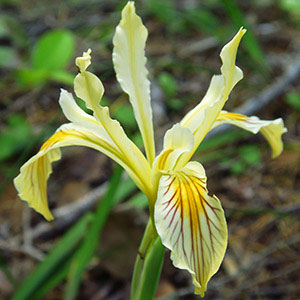Iris bracteata
Iris tenuis
Siskiyou iris
Clackamas iris
sheathed with old leaf bases, slender, 0.6–0.9 cm diam.;
roots few, fibrous.
superficial or very shallow, cordlike portion 1–2 dm × 2 mm, expanding to 10–15 mm diam., nodes with brown, scalelike leaves and few to no roots.
simple, solid, 1.5–3 dm.
1–2-branched, 3–3.2 dm.
basal with abaxial surface of blades deep glossy green on one side of fan, light yellow-green on other side, pink or red-tinged basally, strongly ribbed, 4–6 dm × 0.8–1 cm, rigid, margins not thickened;
cauline 3–6, imbricated, closely sheathing stem ca. 2/3 length, spreading distally, bractlike, blade inflated, often shorter than basal leaves.
basal with blade pale green, 3.2 dm × 1.5 cm, margins scarious basally, apex acute, proximal 2 semi- sheathing, blade 5 cm, scarious;
cauline 1–2, sheathing branch and stem for ca. 1/2 their length, blade ca. 5 cm, semimembranous.
simple, units 1–2-flowered;
spathes closed tightly around pedicel and ovary, lanceolate, 5.2–9 cm × 6–8 mm, subequal, herbaceous, margins scarious, apex acuminate.
2–3-branched, each unit with single flower, all borne at approximately the same level;
spathes 2–3 cm × 5 mm, subequal, scarious except basally and along midrib.
perianth cream to buff-yellow;
floral tube 0.8–0.9 cm;
sepals with deeper yellow signal, veined with purple or brown, obovate-lanceolate, 6.5 × 2.5 cm, base gradually attenuate into wide claw;
petals narrowly oblanceolate, 7–9 × 0.8–2 cm, base gradually attenuate;
ovary nearly circular in cross section, 1.5–2.5 cm, base gradually attenuate into pedicel, apex abruptly acuminate into floral tube;
style 2.2–3 cm, crests spreading, yellow, not veined, 1.2 × 0.9–1.7 cm, margins toothed;
stigmas triangular or tongue-shaped, margins entire;
pedicel 3–6.2 cm.
perianth white or blue tinged with deep violet lines;
floral tube funnelform, 0.3 cm;
sepals oblong-spatulate, 2.8 × 1 cm, apex deeply emarginate, signal an inconspicuous crest with low, yellow, undissected ridge;
petals bluish white, oblanceolate-spatulate, base gradually attenuate into claw;
ovary elliptical, 0.4–0.7 cm;
style 1.8 cm, crests broadly obovate, 0.7 cm, margins erose;
stigmas triangular-acuminate, margins entire;
pedicel 0.4–1 cm, not lifting flower clear of spathes.
nearly circular in cross section, tapering abruptly at each end, 2–2.5 × 1–1.5 cm.
depressed-globose, roundly triangular, 0.9–1.5 × 1.2 cm.
dark brown, irregular in shape, wrinkled.
pale brown, with whitish raphe, D-shaped, pitted.
= 40.
= 28.
Iris bracteata
Iris tenuis
Iris bracteata is limited to one county each in northern California and southern Oregon. It hybridizes with I. chrysophylla, I. douglasiana, I. innominata, I. munzii, I. purdyi, and I. tenax.
(Discussion copyrighted by Flora of North America; reprinted with permission.)
Of conservation concern.
Iris tenuis was originally placed in ser. Californicae, but R. C. Foster (1937) stated, “It is with some hesitation that I leave it in association with them. The broad, pale green leaves are much like those of a giant I. cristata.” F. H. Smith and Q. D. Clarkson (1956) said, “It clearly does not belong in the subsection with the other members of the Californicae,” and Clarkson in a later treatment (1958) created a new subsection, the Oregonae, for it. L. W. Lenz (1959b) moved this species into subsect. Evansia (= sect. Lophiris), with which it shows many relationships.
(Discussion copyrighted by Flora of North America; reprinted with permission.)


